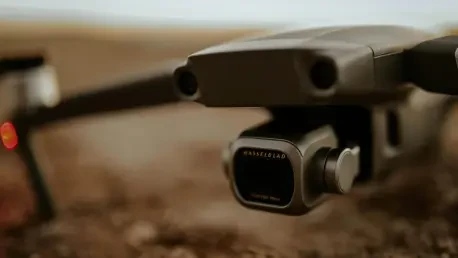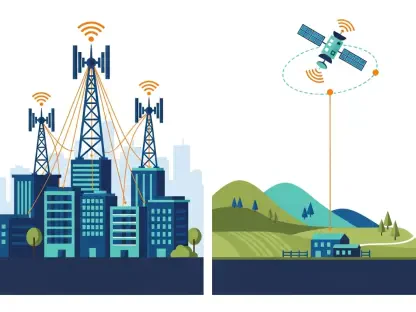In the complex environment of modern military warfare, fiber-optic drones are rapidly emerging as pivotal solutions capable of circumventing electronic warfare’s signal jamming challenges. These advancements play a crucial role in the ongoing Russia-Ukraine conflict, where traditional radio-operated UAVs face significant interference threats. By transmitting signals through light pulses within fiber-optic cables, tethering these drones to operators, they ensure secure communication and reliable operability amid dense electronic attack environments. This evolution underscores a critical shift in the dynamics of drone warfare, as these models offer enhanced data integrity and operational efficacy for both Russian and Ukrainian military forces, sidestepping conventional obstacles associated with radio-controlled systems.
Technological Advancements in Fiber-Optic Drones
The transition from radio-link to fiber-optic control mechanisms in UAVs marks a profound technological evolution with significant implications for modern warfare. These drones have supplanted vulnerable radio-based communications with physical tethers that connect UAVs directly to their operators’ control stations. Extending over 20 kilometers, these cables facilitate the uninterrupted transmission of high-definition video feeds and control signals via light pulses, effectively shielding operations from electronic interference threats that frequently disrupt standard communication channels. This breakthrough offers complete protection against radio-jamming efforts, a prominent hurdle in the current landscape of electronic warfare, as clearly illustrated by events on the Ukrainian battlefields.
Furthermore, the fiber-optic tether ensures real-time data relay, crucial for precision missions such as targeted strikes, reconnaissance, and detailed surveillance operations. Such capabilities make them indispensable assets in military campaigns where conventional, wireless-dependent systems often falter. The direct line of communication provided through these ultra-thin cables not only enhances operational stealth by eliminating radio emissions detectable by enemies but also increases mission success rates by allowing silent, undetectable operations. As a result, fiber-optic drones are proving essential in missions that demand high fidelity in dynamic and hostile electronic environments.
Overcoming Challenges in Electronic Warfare
The advantages of fiber-optic drones extend significantly in the face of prevalent electronic warfare challenges. Recent data revealed that over 73% of standard FPV drones were incapacitated by electronic warfare systems in the early months of the previous year, highlighting the vulnerability of traditional UAV setups in combat zones like Ukraine. In stark contrast, fiber-optic drones present a steadfast connection that remains immune to wireless jamming, enabling engagement in high-stakes missions without hindrance. This resilience in electronic warfare has been recognized by Russian military development as a revolutionary change in tactical planning, reducing mission failure rates previously attributable to jamming incidents.
The operational reliability of fiber-optic drones has led to a reassessment of military strategies, incorporating precision and subterfuge due to diminished risk of electronic detection. The reduced need for radio emissions, which are easily tracked by opposing forces, grants these drones an additional layer of stealth, enhancing their utility in covert missions. The convergence of reliance on fiber-optic technology and success in undisturbed mission execution demonstrates a significant evolution in military doctrine, emphasizing the importance of securing communication lines amidst sophisticated electronic threats.
Navigating Operational Constraints
While fiber-optic drones present formidable advantages, they are not without their own set of operational limitations and challenges. Among these are increased risks of the tethered cable becoming snagged, particularly in urban environments and dense, forested areas. This necessitates adaptive strategies to mitigate potential snags, such as developing carefully plotted flight paths and planning angled approaches to reduce entanglement risks. Moreover, the tethering mechanism may restrict the drones’ maneuverability in comparison to more agile, FPV-certified drones, prompting military engineers to innovate hybrid UAV designs and optimize cable-deployment systems to enhance functionality.
Payload and range limitations also present challenges, as the maximum payload and range of fiber-optic drones are often lesser than those of entirely untethered counterparts. These constraints set a technical benchmark for continual advancements in materials, such as developing lightweight composite structures and optimizing explosive payloads to maximize operational capabilities. These developments are crucial in expanding the operational envelope of fiber-optic UAVs, allowing them to fulfill a wider range of mission types traditionally dominated by untethered systems.
Environmental and Strategic Considerations
Beyond operational aspects, there is growing concern about the environmental impact posed by discarded fiber-optic cables on the battlefield. Emerging initiatives aim to address these concerns by exploring eco-friendly development paths, such as designing biodegradable cables that dissolve after deployment to minimize ecological damage. This is particularly pertinent as military operations increasingly leave significant amounts of fiber remnants strewn across active combat zones, necessitating sustainable practices to mitigate environmental hazards.
From a strategic perspective, the deployment of fiber-optic drones has fueled an escalated arms race between Ukraine and Russia, as both nations seek to leverage their technological edge. Since the beginning of the year, Russian forces have extensively used these systems across countless military fronts, including sabotage operations and defensive deployment maneuvers. Recognizing the strategic advantages and effectiveness of fiber-optic technologies, Ukraine has accelerated its own development and integration of these drones, with domestic manufacturers focusing on miniaturization, enhanced retraction systems, and payload capacity optimization.
Future Prospects and Implications
The shift from radio-link to fiber-optic control systems in UAVs signifies a major technological advancement, profoundly affecting modern warfare tactics. Unlike traditional radio-based methods, fiber-optic tethers physically connect drones to operators over spans of up to 20 kilometers, allowing continuous, high-definition video and control signal transmission through light pulses. This setup effectively shields drone operations from electronic interference, a common issue with radio communications, highlighted by disruptions faced in Ukrainian warfare. Fiber optics eliminate vulnerability to radio-jamming, a significant threat in electronic conflict.
These tethers also ensure immediate data transfer, essential for precision tasks such as strikes, reconnaissance, and surveillance. Fiber-optic UAVs are crucial where wireless systems struggle, providing stealth operations by avoiding radio emissions detectable by enemies and boosting mission success through silent, invisible tactics. Thus, they are becoming indispensable for missions requiring high fidelity in ever-changing, hostile electronic landscapes, demonstrating their vital role in military strategy.









